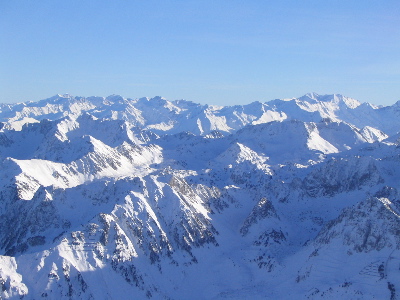I’ve been invited by Josele J. Saiz to stay a couple of day at his Boletas Birdwatching Centre in the Sierra de Guara in Huesca. More on him soon. While there I hope to talk to Oscar Díaz of the Fundación Quebrantahuesos (English) as part of research for the book. FCQ, one of the most active wildlife groups in the Pyrenees, works in the conservation of lammergeyers, but also in the conservation of the Pyrenees in general. I’ve been doing a bit of background reading on the lammergeyer or bearded vulture. What an utterly remarkable bird this is.

Photo by F. Marquez.
This is the world’s only bone-eater. They feed on marrow which they get by dropping bones repeatedly onto rocks, as their Spanish name, quebrantahuesos, aptly suggests. They’ll come back again and again to their favourite rocky areas known in English as ossuaries.
The evocative English Lammergeier or Lammergeyer (both correct) comes from the German, lammergeier, meaning “lamb-vulture“. This was apparently coined by 19th century naturalists due to the mistaken and incredibly widespread belief across Central Europe that they would take young lambs.
They are also known in English as bearded vultures. This is in reference to the ochre ruff of quills they sport around their necks. They are not born with this colour, but acquire the colour by actively seeking out iron-rich muds and rubbing their feathers in them. One theory goes that in a stand-off, the redder the feather, the tougher the lammergeyer, though I need to check this.
The female lammergeyer lays one egg, and then a few days later, lays another. The second chick plays the role of a substitute if the first egg fails to hatch. In most cases, the second chick dies, despite the efforts of its parents to feed it: the older sibling is stronger and takes its food. And then, when the right moment arrives it will kill its brother or sister. This is known by biologists as Cainism, the advantage being that if the first chick fails to hatch or dies young the second chick is at hand. Some of these second chicks are now being rescued are used as part of a captive breeding programme in Andalucia.
• The most serious problem for the bird is poisoning. Some 40% of unnatural deaths of lammergeyers in Spain are from poisoned meat put out principally, these days, to kill foxes, though in the past the bird also suffered from more direct persecution
• Unusally, reproductive units can be comprised of two or three adults. Groups of three appear to be more common that thought. In the latter case there usually are two males and one female, although exceptionally reproductive units made up of four specimens have been observed. The members of the group mount each other as part of a bizarre mating simulation, male on male and female on male.
Currently the Spanish Pyrenean population is comprised of around 125 occupied territories (2004) with an estimated pre-adult population of 156-162 specimens distributed in an area of 21,000 km2. Perhaps the best site to them is the Sierra de Guara with 12 bearded vulture territories, the densest population in Europe. ,
There really is so much more. Just about the only live prey they take are tortoises, which they also dash on the rocks, though as they have been pushed out of low-lying areas this may no longer occur, and certainly not in Spain. Legends abound across Eurasia and Africa. There are for instance strong associations with the pheonix and the bearded vulture. More on this soon. More on lammergeyers in Spain and here on lammergeyer around the world




 Photo El País
Photo El País



